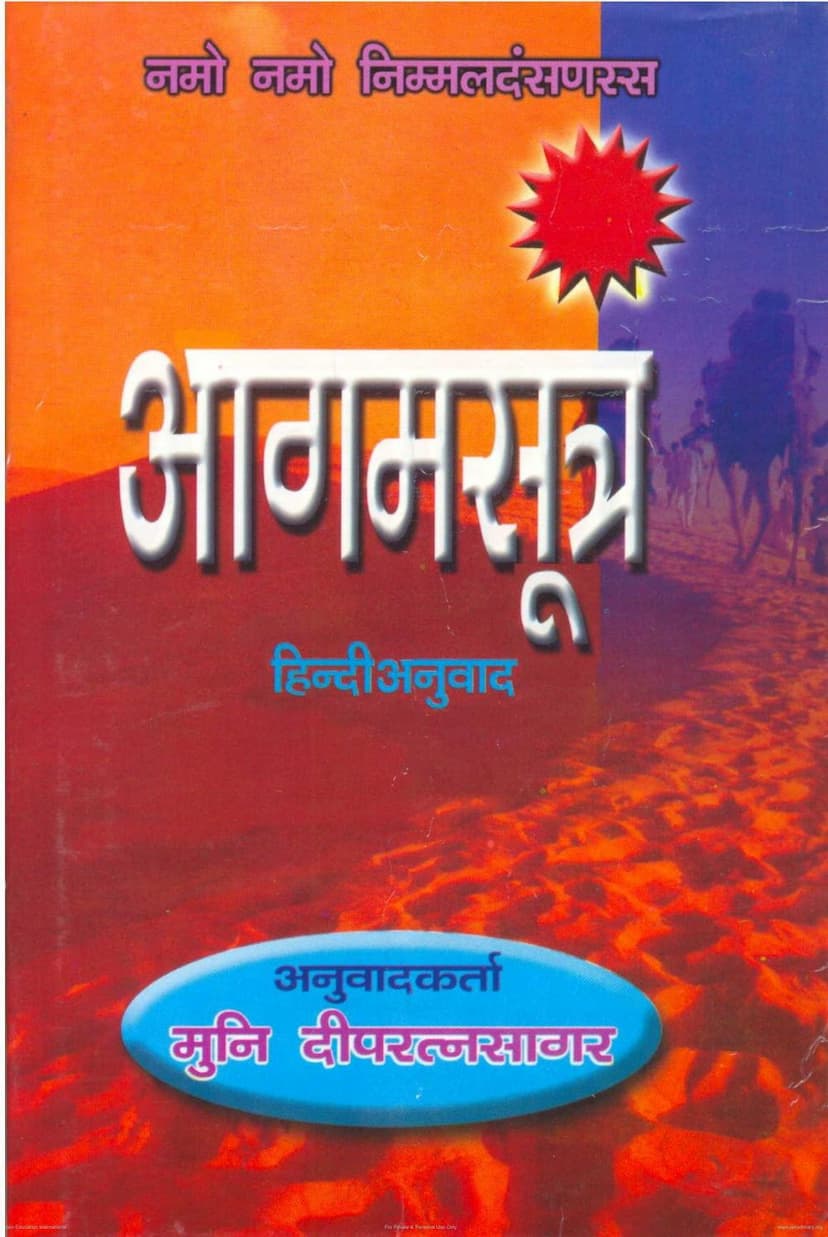Agam Sutra Hindi Anuvad Part 05
Added to library: September 1, 2025

Summary
The provided text is the fifth part of a Hindi translation of the Agam Sutra, specifically focusing on sections of the Bhagavati Sutra (Centuries 30-41), Jñātādharmakaḻā, and Upāsakadaśā. The translation is attributed to Muni Deepratnasagar and published by Agam Aradhana Kendra.
Here's a comprehensive summary of the content based on the provided pages:
Book Details:
- Title: Agam Sutra Hindi Anuvad Part 05 (आगमसूत्र हिन्दी अनुवाद भाग: ५)
- Author: Muni Deepratnasagar (मुनि दीपरत्नसागर)
- Publisher: Agam Aradhana Kendra (आगम आराधना केन्द्र)
- Content: Bhagavati (Centuries 30-41), Jñātādharmakaḻā, Upāsakadāśā.
- Key Sections Covered: The text is a detailed Hindi translation of specific parts of these Jain Agamas, as indicated by the page-wise breakdown of contents.
Key Themes and Content:
The provided text is primarily an index and translation of specific sections of three major Jain Agamas:
-
Bhagavati Sutra (शतक ३० से ४१):
- The text details the content from Century 30 onwards, covering dialogues and teachings of Lord Mahavira.
- Century 30: This section appears to focus on discussions about kriyavadi (believers in action), akriyavadi (believers in non-action), ajnanavadi (believers in ignorance), and vinayavadi (believers in discipline). It delves into how these classifications relate to different types of beings (e.g., Nairayika - hell beings, Prithvikayika - earth element beings, etc.) and their karmic implications, particularly concerning the types of lifespan they bind. The discussions explore the nature of these beliefs and their consequences on beings' existences, including their potential for liberation (bhavasiddhik) or not (abhavasiddhik).
- Century 31: This century appears to discuss classifications related to kshudra-yugma (minor conjunctions) and their implications for beings, particularly hell-dwellers. It examines the origins, numbers, and characteristics of beings reborn in different hellish realms, often linking them to specific karmic states or classifications like krishnaleshya (black passion-color) and bhavasiddhik/abhavasiddhik status.
- Century 32: This section seems to focus on the process of udvartana (ascending migration or movement) of beings after death, tracing their paths and subsequent births, again in relation to various classifications.
- Centuries 33-41: The index suggests these centuries continue the detailed exposition of Lord Mahavira's teachings, covering various philosophical concepts, karmic principles, and the nature of different types of souls and their experiences. The sheer volume of indexed texts indicates a deep dive into intricate Jain philosophical and cosmological matters.
-
Jñātādharmakaḻā (ज्ञाताधर्मकथा):
- This section describes the lives and teachings of prominent lay followers (śrāvakas) and mendicants who achieved spiritual realization.
- Study 1: Ānanda (आनन्द): This study details the life of Ānanda, a prominent lay follower of Lord Mahavira. It highlights his virtuous qualities, his devotion, and his adherence to Jain principles, particularly his exemplary practice of lay vows (śrāvaka-dharma). The narrative focuses on his commitment to his vows even in challenging circumstances and his ultimate attainment of a favorable rebirth.
- Study 2: Kāmadeva (कामदेव): This study likely explores the story of a person named Kāmadeva and their spiritual journey, possibly involving overcoming worldly attachments and desires.
- Study 3: Chullapita (चुल्लनीपिता): This study narrates the life of Chullapita, likely a lay follower who exemplifies certain spiritual practices or principles.
- Subsequent Studies (4-10): The index lists several other studies (Surādeva, Chuḷḷashataka, Kuṇḍakolika, Saddālaputra, Mahāshataka, Nandinīpitā, and Laiyāpitā). These studies would likely detail the lives and spiritual paths of these individuals, showcasing the practical application of Jain teachings and the attainment of spiritual merit. The text provides extensive detail about their actions, their adherence to vows, and the karmic consequences of their deeds.
-
Upāsakadāśā (उपासकदशा):
- This Agama describes the vows and conduct of ten prominent lay followers (upāsakas) of Lord Mahavira.
- The text begins by outlining the structure of this section, mentioning ten students/learners, starting with Ānanda.
- Study 1: Ānanda (आनन्द): This study is presented in detail. It describes Ānanda's wealth, his family life, his eventual renunciation after hearing Lord Mahavira's teachings, and his adherence to the eleven śrāvaka vows. It highlights his unwavering devotion and the purity of his conduct, even when facing severe challenges. The narrative also includes the story of his wife Shivānanadā and her own spiritual journey.
- Subsequent Studies (2-10): The text indicates that studies on Kāmadeva, Chullashataka, Kuṇḍakolika, Saddālaputra, Mahāshataka, Nandinīpitā, and Laiyāpitā are also covered, each likely focusing on the life and spiritual progress of these lay followers.
Overall Purpose:
This volume of the Agam Sutra translation serves as a comprehensive resource for understanding key Jain philosophical concepts, the lives of significant spiritual practitioners (both mendicants and lay followers), and the practical application of Jain ethics and principles. It aims to provide detailed narratives and teachings that illuminate the path to liberation according to Jainism. The extensive index at the beginning further demonstrates the breadth of Jain literature covered by the publishing institution.